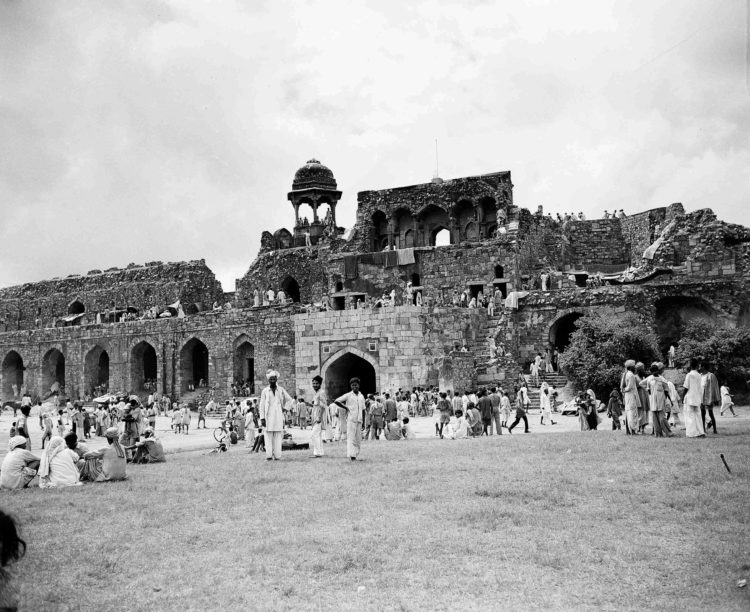
In this Sept. 17, 1947 file photo, Muslim refugees, evacuated from areas of unrest in New Delhi, take shelter in the corners of the ancient walls of Purana Qila, the old fort, in New Delhi, India. When the British ended two centuries of colonial rule on the Indian subcontinent in August 1947, they left a jigsaw legacy _ the vast country of India flanked on either side by a newly created Pakistan split in two parts. Excitement over independence was quickly overshadowed by some of the worst bloodletting the world has ever seen, leaving up to 1 million people dead as gangs of Hindus and Muslims slaughtered each other.
“The Jungle Prince of Delhi,” a 2020 Pulitzer finalist in the feature writing category, is a riveting excavation of the truth of a family stained by the trauma of the post-colonial Partition, the violent, religion-based separation of India and Pakistan.
“This is a very peculiar story,” Barry said. “I don’t think I’ll ever write anything like that again.”

Ellen Barry
Barry was the chief foreign correspondent for The New York Times until recently and now based in Boston. She is a three-time Pulitzer Prize finalist and was a partner on a project about the justice system in Russia that won the 2010 Pulitzer in international reporting.
She wasn’t the first reporter to write about the mysterious royal family of Oudh, which was said to be the last of the Shiite Muslim royal line and had chosen to be cut off from the rest of the country. For almost half a century, the family granted special access to foreign correspondents (they refused to entertain Indians) to document their life and grievances. But Barry soon realized and acknowledged in the article that they were reluctant to open up about who they are and where they came from. She weaves her own experiences into her profile, along with her misgivings about the family’s motives:
Why summon a journalist if you don’t want to be written about?
Barry, familiar with the countless newspaper articles that quoted Queen Wilayat, Prince Cyrus and Princess Sakina, was the first reporter to question the authenticity of their story. Were they really who they claimed to be?
“I was very stuck on the question of why foreign correspondents always wanted this so badly and kept gravitating back to it, while in the end, Indian journalists were more or less shut out from pursuing it,” she told me in an interview.
The 7,600-word article is unique because readers are allowed to look deep into the reporting process, the narrator’s feelings and the trajectory of the narrator’s relationship with her sources, especially with Prince Cyrus. Barry’s deliberate and careful integration of soul-stirring first-person narrative with documents, news clippings and sources dug up from the past, makes “The Jungle Prince of Delhi,” a handbook for journalists hoping to uncover the truth in a foreign land.
“This was, in some ways, a story about how foreign correspondents do their job,” she said.
Revealing “slivers of yourself” through voice
Barry has experimented with first-person narrative and voice before. In “How to Get Away with Murder in Small-Town India,” she took an idiosyncratic approach of using a comical voice and positioning herself as an unaccepted white reporter investigating the coverup of a woman’s murder in a small rural Indian town.
“When you use first person, you’re making lots of choices about slivers of yourself or versions of yourself that are carefully put together,” she said.
A private person, Barry isn’t comfortable divulging the personal particulars of her reporting, she said. For “The Jungle Prince of Delhi,” however, she had to make an exception to fill gaps of information and evidence. Records of many sources had been wiped out during the 1947 Partition, and documents had not been digitized.
It was also necessary to show how the nature of the investigation changed over time, she said. In a moving description, she tells the reader how her relationship with Prince Cyrus, who lived most of his life as a recluse, deepened and morphed during the 18 months of reporting.
One night Cyrus called me, howling unintelligibly, to tell me that his sister had in fact died seven months earlier. He had told no one, burying her body himself. He had lied to me about it for months and seemed a bit ashamed by it. I curled up on my daughter’s bunk bed and listened to his voice over the phone. He said that I should never visit again, and also that he was so lonely.
I waited a few days and then showed up with a Filet O’ Fish from McDonald’s.
After a long debate with her editor, she agreed to write about the time Cyrus asked her to kiss him on the cheek as he had not been kissed in 10 years. Brick by brick, she breaks down the wall between journalist and subject as she describes the desolate moments when she heard that Cyrus had died.
I was sad that I was not there to help him… I was sure that in the dark, he had wanted someone to hold his hand.
Thinking about this made it difficult to breathe.
A story soaked in regional history
Writing about her relationship with Cyrus was challenging, but the sections Barry struggled to write the most were those about India’s colonial past, the Partition and the carnage that followed, uprooting so many lives and homes and displacing several families including the royal family of Oudh.
“What we were struggling with is where to inject these sections about the past without slowing down the story,” she said. “In a lot of cases, we had to reduce how much we were saying because we’re afraid of losing the reader.”
The story is chronologically structured and made up of 10 sections that Barry uses to dissect history and discover a theme of unresolved trauma and its impression on Wilayat, who claimed to be the Queen of Oudh.
It was hard to get away from Wilayat as the story revolved around her and her claim to the annexed kingdom of Oudh, Barry said. The would-be queen had declared that she would live in a railway station until her properties were rightfully restored to her after which she was given a palace by the Indian prime minister. Years later, her daughter told the world that Wilayat had killed herself by drinking poison mixed with crushed diamonds.
But Wilayat was long dead before Barry began reporting this story. She pieced together Wilayat’s gripping personality through documents, her daughter’s diary, letters, previous news articles and an old painting that hung on a wall in the palace. She also interviewed distant relatives of the family, scattered across the country and the globe, and people who knew them at the time.
“Most of the people who knew the facts of the case were dead, and those who weren’t dead, didn’t want to talk about it,” she said.
Writing for a Western audience
Barry’s writing is imbued with techniques like foreshadowing, descriptive details and apt analogies which make a regional story relatable and easy to digest for a Western audience. For instance, she describes Oudh as “a territory roughly the size of South Carolina.”
Barry said she maintains a binder with relevant details that she collects while reporting and the most telling quotes that later serve as the building blocks for her story. She’s habitual about typing up a scene from memory as soon as she can.
If you don’t have a scene, you don’t have a story, the Pulitzer award winner said. Here’s how she sets the scene for a pivotal moment in the story right before she finally finds the truth:
It was a gray, windblown day, and the walk took me past pawnshops, cheap Chinese takeout joints and dinky row houses of yellow brick, nearly all of them occupied by immigrants from India and Pakistan. I arrived, finally, at a small, neat brick house that was surrounded by a large collection of ceramic garden gnomes, teddy bears, Yorkies, mermaids and fairies.
She pairs the complex story with a familiar genre: mystery. Readers are hooked right from the beginning and are compelled to read all the way to the end to find out the veracity of the roots of an intriguing royal family. “To get the payoff, you have to reach the end,” Barry said.
Is the truth really worth it?
The story begins with a scene: A much-awaited telephone message is relayed to her by an office manager. Their conversation sprinkles in the eagerness in the voice of a narrator, who wants a break from mundane stories and instead to uncover one of the city’s biggest mysteries.
The story ends with a scene: The narrator sits in the middle of the cemetery where Cyrus’ unclaimed body is buried. This is where Barry introduces a new character in the story, a city dweller and stern believer in the royal family of Oudh wondering why nobody cares that an important man has died.
“What I liked about the conclusion is that it sort of fogs the importance of whether their story was true or not,” she said. “As it becomes clear that their story mattered to people for a long time, and the reason it mattered is sort of indisputably true.”
Barry went into the jungle looking for a groundbreaking story. And though the royal family of Oudh had a tumultuous past that they hid from the world, the truth of whether they were royal didn’t matter as much as how they were revered by the people in the city.
“The most scary thing about telling these stories is getting the relationships wrong or getting the history wrong or telling a story that people thought wasn’t worth telling,” Barry said.
Barry said she was more apprehensive about how the story was received by readers in India and Pakistan than elsewhere. She was relieved to receive feedback from readers who felt it was a story worth being told.
I grew up in India, listening to stories about the partition from my grandparents. But the trauma of the partition has been swept under the carpet in many ways, only dusted out for scenes in Bollywood movies. During our interview, Barry asked me if I felt the story was relevant so many years after the partition. The story of the royal family of Oudh is not only valuable to budding journalists but also to show readers the complexity of the truth.
***
Rashi Shrivastava is a graduate student at the University of Missouri majoring in magazine journalism.


